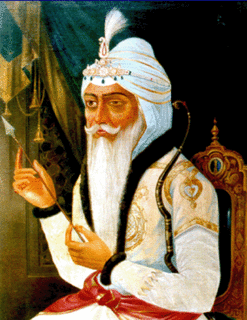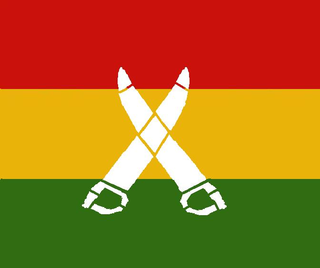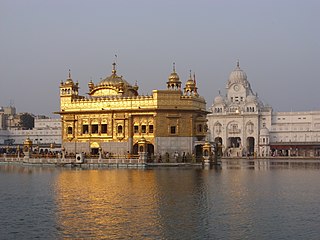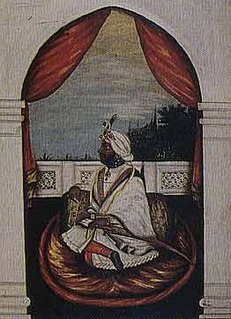
The Punjab, also spelled Panjab, is a geopolitical, cultural and historical region in South Asia, specifically in the northern part of the Indian subcontinent, comprising areas of eastern Pakistan and northern India. The boundaries of the region are ill-defined and focus on historical accounts.

Sikhs are people associated with Sikhism, a monotheistic religion that originated in the 15th century, in the Punjab region in the northern part of the Indian subcontinent, based on the revelation of Guru Nanak. The term "Sikh" has its origin in the Sanskrit words शिष्य, meaning a disciple, or a student. A Sikh, according to Article I of the Sikh Rehat Maryada, is "any human being who faithfully believes in One Immortal Being; ten Gurus, from Guru Nanak to Guru Gobind Singh; Guru Granth Sahib; the teachings of the ten Gurus and the baptism bequeathed by the tenth Guru".

Maharaja Ranjit Singh (1780 –1839) was the leader of the Sikh Empire, which ruled the northwest Indian subcontinent in the early half of the 19th century. He survived smallpox in infancy but lost sight in his left eye. He fought his first battle alongside his father at age 10. After his father died, he fought several wars to expel the Afghans in his teenage years and was proclaimed as the "Maharaja of Punjab" at age 21. His empire grew in the Punjab region under his leadership through 1839.
The Punjabis or Punjabi people are an ethnic group associated with the Punjab region in South Asia, specifically in the northern part of the Indian subcontinent, presently divided between Punjab, India and Punjab, Pakistan. They speak Punjabi, a language from the Indo-Aryan language family. The name Punjab literally means the land of five waters in Persian: panj ("five") āb ("waters"). The name of the region was introduced by the Turko-Persian conquerors of the Indian subcontinent. The historical Punjab region is often referred to as the breadbasket in both India and Pakistan.

Khatri is a predominantly Hindu caste of northern India and Pakistan, mostly from the Punjab region, that provided many significant figures in Sikhism, including all of the Sikh Gurus.

The First Anglo-Sikh War was fought between the Sikh Empire and the East India Company between 1845 and 1846. It resulted in partial subjugation of the Sikh kingdom and cession of Jammu and Kashmir as a separate princely state under British suzerainty.

The Second Anglo-Sikh War was a military conflict between the Sikh Empire and the British East India Company that took place in 1848 and 1849. It resulted in the fall of the Sikh Empire, and the annexation of the Punjab and what subsequently became the North-West Frontier Province, by the East India Company.

Kasur is a city located to south of Lahore, in the Pakistani province of Punjab. The city serves as the headquarters of Kasur District, and is located near the border with neighbouring India. Founded by Pashtun migrants in 1525, Kasur is now the 20th most populous city of Pakistan, and is renowned as the burial place of the legendary 17th century Sufi-poet Bulleh Shah.

The Ghadar Party was an Indian revolutionary organisation primarily founded by Punjabis. The party was multi-ethnic and had Sikh, Hindu and Muslim leaders. The party was headquartered in San Francisco, United States. Key members included Bhai Parmanand, Sohan Singh Bhakna, Bhagwan Singh Gyanee,Har Dayal, Mohammad Iqbal Shedai, Kartar Singh Sarabha, Abdul Hafiz Mohamed Barakatullah, Sulaman Choudhary, Aamir Choudhary, Rashbehari Bose and Gulab Kaur.

The Sikh Empire was a major power originating in the Indian subcontinent, formed under the leadership of Maharaja Ranjit Singh, who established a secular empire based in the Punjab. The empire existed from 1799, when Ranjit Singh captured Lahore, to 1849 and was forged on the foundations of the Khalsa from a collection of autonomous Sikh misls. At its peak in the 19th century, the Empire extended from the Khyber Pass in the west to western Tibet in the east, and from Mithankot in the south to Kashmir in the north. The religious demography of the Sikh Empire was Muslim (80%), Sikh (10%), Hindu (10%). The population of the empire was 3.5 million in 1831. It was the last major region of the Indian subcontinent to be annexed by the British.

The Majha region is recognized as the region that is located at the center of the historical Punjab region, that is northward from the right banks of river Beas, and extends up to river Jhelum at its northmost. People of the Majha region are given the demonym "Mājhi". The Majhi dialect of Punjabi language is the main language of this region, which is also the standard dialect of the Punjabi language. The most populous city in the area is Lahore on the Pakistani side of the border.
The history of Sikhism started with Guru Nanak Dev Ji, the first Guru in the fifteenth century in the Punjab region in the northern part of the Indian subcontinent. The religious practices were formalised by Guru Gobind Singh Ji on 13 April 1699. The latter baptised five persons from different social backgrounds to form Khalsa (ਖ਼ਾਲਸਾ). The first five, Pure Ones, then baptised Gobind Singh into the Khalsa fold. This gives the order of Khalsa, a history of around 300 years.
Malwa is the region of Punjab that lies to the south of Majha, separated by the Satluj river, and to the north and west of Poadh.
Jat Sikh is a sub-group of the Jat people and the Sikh community, from the Indian subcontinent. They form nearly 21%-25% of the population of the Indian state of Punjab. and are thus the second most populous social group there after the Dalits.

Sikhism is the fourth largest religion in India and has existed for 548 years, beginning with the birth of its founder Guru Nanak. The Sikhs are predominantly located in Punjab, but also in many other parts of India. It is also the fifth largest religion in the world, with more than 27 million followers in the world as of the year 2010.

The Sikh diaspora is the modern Punjabi Sikh migration from the traditional area of the Punjab region. Sikhism is an ethnic religion, the Punjab region being the historic homeland of Sikhism. The Sikh diaspora is largely a subset of the Punjabi diaspora.

Punjab is a state in northern India. Forming part of the larger Punjab region of the Indian subcontinent, the state is bordered by the Indian states of Jammu and Kashmir to the north, Himachal Pradesh to the east, Haryana to the south and southeast, Rajasthan to the southwest, and the Pakistani province of Punjab to the west. The state covers an area of 50,362 square kilometres, 1.53% of India's total geographical area. It is the 20th-largest Indian state by area. With 27,704,236 inhabitants at the 2011 census, Punjab is the 16th-largest state by population, comprising 22 districts. Punjabi is the most widely spoken and official language of the state. The main ethnic group are the Punjabis, with Sikhs (58%) forming the demographic majority. The state capital is Chandigarh, a Union Territory and also the capital of the neighbouring state of Haryana. The five rivers from which the region took its name were Sutlej, Ravi, Beas, Chenab and Jhelum; Sutlej, Ravi and Beas are part of the Indian Punjab.
The Janjua is a caste found among the Sikh, Hindu and Muslim Rajputs communities of Pakistan and India.












